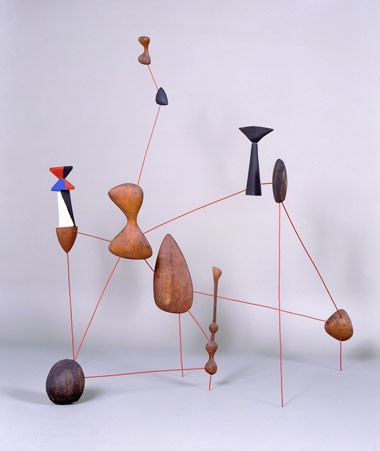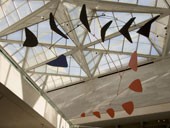
Students will be introduced to one of the basic elements of art—form—by analyzing the types of forms and materials used in various sculptures. Students will then experiment with line in both two and three dimensions to see how shapes become forms.

Alexander Calder
American, 1898–1976
Vertical Constellation with Bomb, 1943
painted steel wire, painted wood, and wood, 77.5 x 75.6 x 61 cm (30 1/2 x 29 3/4 x 24 in.)
National Gallery of Art, Gift of Mr. and Mrs. Klaus G. Perls
© 2000 Estate of Alexander Calder / Artists Rights Society (ARS), New York
What do the forms on this sculpture remind you of? Can you find geometric shapes? Do some of the forms look like things in nature?
Imagine using an air pump to inflate flat shapes. What do you get? Form! Forms are shapes in three dimensions:
Circle —> Sphere
Square —> Cube
Rectangle —> Rectangular prism
Triangle —> Pyramid
These are geometric forms, which are precise and regular. Have students feel the forms of various objects that are spheres, cubes, and pyramids. They are often found in human-made things, like buildings and machines while biomorphic shapes are found in nature. These shapes may look like leaves, flowers, clouds—things that grow, flow, and move. The term biomorphic means: life-form (bio=life and morph= form). Biomorphic shapes are often rounded and irregular, and can also turn into forms. Sculpture is the most obvious place to see form, or three-dimensional shape, in art.
This work of art by Alexander Calder includes both geometric and biomorphic forms. His training as an engineer was important to his working method. Known for carrying a pair of pliers with him at all times, Calder’s first contribution to modern sculpture was working exclusively in wire during the 1920s. Early sculptures, which have been described as three-dimensional drawings, were mainly portraits of friends and depictions of animals or circus characters.

An example of one of Calder’s mobiles
Alexander Calder
American, 1898–1976
Untitled, 1976
aluminum and steel, 910.3 x 2315.5 cm (358 3/8 x 911 5/8 in.) gross weight: 920 lb.
National Gallery of Art, Gift of the Collectors Committee
Alexander Calder invented mobiles—sculptures that moved—in the early 1930s. During World War II, Calder created the Constellations series. The pieces are motionless, called stabiles, yet airy, like mobiles. Many, for example Vertical Constellation with Bomb, rest on a flat surface, but some Constellations are mounted from the wall at an angle. Generally, they are composed of small abstract forms carved from wood that are carefully arranged in three dimensions. The materials are either painted or left unfinished. Vertical Constellation with Bomb is one of the more complex works in the series, combining forms of varying sizes that define broader three-dimensional space than other Constellations. On the periphery, smaller forms reach out, suggesting movement into further horizons. There are five bare wooden forms and five painted forms, four of which are black. The wires are painted red.
View the slideshow below to have students describe the forms they see by answering the following questions for each sculpture:
Slideshow: Form in Works of Art
previous slides
Roy Lichtenstein
American, 1923–1997
House I, model 1996, fabricated 1998
fabricated and painted aluminum, 292.1 x 447 x 132.1 cm (115 x 176 x 52 in.), gross weight: 1900 lb.
National Gallery of Art, Gift of The Morris and Gwendolyn Cafritz Foundation

Sol LeWitt
American, 1928–2007
Four-Sided Pyramid, first installation 1997, fabricated 1999
concrete blocks and mortar, 458.2 x 1012.2 x 970.9 cm (180 3/8 x 398 1/2 x 382 1/4 in.)
National Gallery of Art, Gift of the Donald Fisher Family

Jean Arp
French, born Germany (Alsace), 1886–1966
Oriforme, model 1962, fabricated 1977
stainless steel, 227.9 x 214.6 x 60 cm (89 3/4 x 84 1/2 x 23 5/8 in.), gross weight: 1400 lb. (635.036 kg)
National Gallery of Art, To the American People in Gratitude - Leon Chalette, Arthur Lejwa and Madeleine Chalette Lejwa

Pablo Picasso
Spanish, 1881–1973
Head of a Woman (Fernande), model 1909, cast before 1932
bronze, 41.2 x 20.5 x 25.5 cm (16 1/4 x 8 1/16 x 10 1/16 in.)
National Gallery of Art, Patrons' Permanent Fund and Gift of Mitchell P. Rales
© 2012 Estate of Pablo Picasso/Artists Rights Society (ARS), New York
 lightly mottled in a rich honey-brown color, except at the top of the front face of the U’s arm, which looks as if it were cut vertically to expose an elongated oval shaped disk of highly polished, bright gold-colored bronze. A third form appears as a straight vertical element behind and to the left of the U-shaped piece. The building behind the sculpture has two stories of floor-to-ceiling windows, which reflect darkly in this photograph. The floor and ceiling above the sculpture, where the entryway covers it, are smooth, buff-pink stone. Two rows of deep-set triangles recede into the ceiling." />
lightly mottled in a rich honey-brown color, except at the top of the front face of the U’s arm, which looks as if it were cut vertically to expose an elongated oval shaped disk of highly polished, bright gold-colored bronze. A third form appears as a straight vertical element behind and to the left of the U-shaped piece. The building behind the sculpture has two stories of floor-to-ceiling windows, which reflect darkly in this photograph. The floor and ceiling above the sculpture, where the entryway covers it, are smooth, buff-pink stone. Two rows of deep-set triangles recede into the ceiling." />
Henry Moore
British, 1898–1986
Knife Edge Mirror Two Piece, 1976–1978
bronze, 534.5 x 721.1 x 363.1 cm (210 7/16 x 283 7/8 x 142 15/16 in.) gross weight: 5 ton
National Gallery of Art, Gift of The Morris and Gwendolyn Cafritz Foundation

Martin Puryear
American, born 1941
Lever No. 3, 1989
carved and painted wood, 214.6 x 411.5 x 33 cm (84 1/2 x 162 x 13 in.)
National Gallery of Art, Gift of the Collectors Committee

Alexander Calder
American, 1898–1976
Rearing Stallion, c. 1928
wire and painted wood, 57.8 x 34.3 x 24.8 cm (22 3/4 x 13 1/2 x 9 3/4 in.)
National Gallery of Art, Gift of Mr. and Mrs. Klaus G. Perls
© 2000 Estate of Alexander Calder / Artists Rights Society (ARS), New York
While studying at the Art Students League in New York, Alexander Calder developed a talent for continuous line drawing: creating an image with one single, unbroken line. He further honed his skills as a draftsman while working for several newspapers in New York City. Calder’s exploration of line moved into three dimensions when he began to create sculptures made of wire, like Rearing Stallion (right), a material that he had loved since he was a boy.
Students will experiment with line in both two and three dimensions to see how shapes become forms:
Exhibit the sculptures next to the line drawings for class discussion. (To display the wire sculptures, they can either be stuck into a lump of clay or be hung up with string.) Student artists should each answer the following questions about their process:
The Elements of Art is supported by the Robert Lehman Foundation
VA:Cn10.1.3 Develop a work of art based on observations of surroundings.
VA:Cr2.2.4 When making works of art, utilize and care for materials, tools, and equipment in a manner that prevents danger to oneself and others.
VA:Re7.1.4 Compare responses to a work of art before and after working in similar media.
VA:Re8.1.3 Interpret art by analyzing use of media to create subject matter, characteristics of form, and mood.